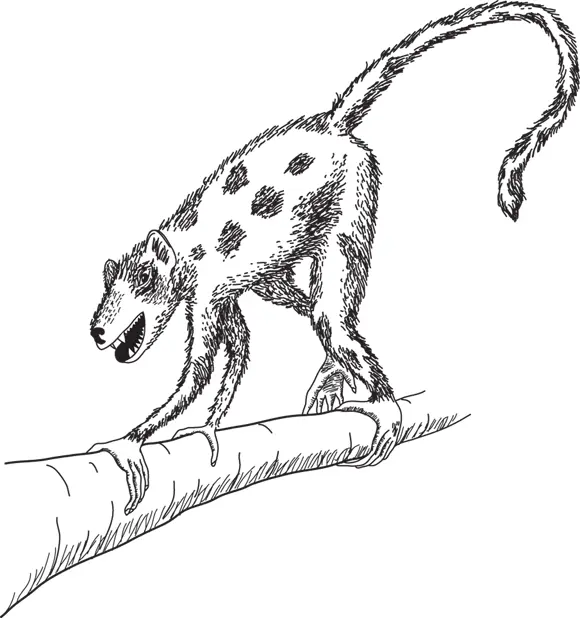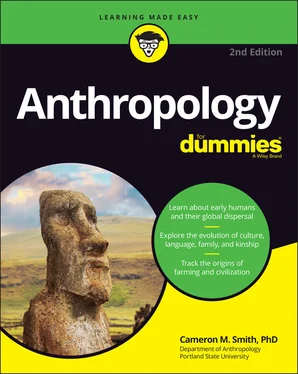Discover how archaeologists learn about the past.
Find the origins of humanity in the ancient fossil record.
Identify the distinctive features of our species, Homo sapiens sapiens.
Follow the early dispersal of modern humans across the globe.
Understand when and where farming was first invented.
Observe the evolution of humanity’s first civilizations.
Chapter 4
The Wildest Family Reunion: Meet the Primates
IN THIS CHAPTER
 Discovering when and where the primates first evolved
Discovering when and where the primates first evolved
 Distinguishing the characteristics of different primate groups
Distinguishing the characteristics of different primate groups
 Understanding the various aspects of primate behavior
Understanding the various aspects of primate behavior
 Saving endangered primates before it’s too late
Saving endangered primates before it’s too late
There are millions of kinds of living things (some estimate that millions more are undiscovered in the jungles and oceans), and making sense of them has been the labor biologists for centuries. (Check out the “Biological classification” sidebar in this chapter for more on this process.) Among these swimming, hopping, and crawling life forms are the primates, a group of about 200 kinds of animal that share some distinctive anatomical and behavioral characteristics. This is the Primate order, our home in the biological world.
To better understand the human species, anthropology has taken up the study of our closest relatives: Where do they come from? How long have they been living there? Why do they eat the things they eat? This chapter gives you an overview of what that family is like and how you fit in.
Monkey Business: Primate Origins
The earliest proto-primates have been traced from fossils of the Paleocene epoch some 65 million years ago; most anthropologists agree that the Primate order was well underway by 60 million years ago. The number 65 million may ring a bell as the time of the extinction of the dinosaurs, and the rise of primates is related to the demise of the dinosaurs. Early mammals, from which the primates evolved, appear somewhat earlier, but when the dinosaurs became extinct, the way opened up for other life forms to flourish. Many more mammals show up after 65 million years ago, and among them are the first primates.
Many fossils of early primates are found in Europe and North America, which is a little jarring, because there aren’t natural primate populations in these areas — well, except for humans! — today. This is because at this time, the continents were differently arranged than they are today.
In addition to the fossil evidence for primate origins, today we have a tremendous paleogenomic (ancient DNA) record. This evidence largely corroborates what the fossils have been telling us for over a century. It also provides fascinating new details, such as a detailed chronology of the evolution of different lineages. The DNA record, for example, tells us that the New World primates (those of South and Central America) split from the Old World primates about 35 million years ago, which ties up nicely with geological evidence for continental drift around this time.
The fossils of the earliest primates show two main features:
Small body size, averaging roughly 150 to 3,000 grams, or about 1⁄3 pound to about 6 pounds
Teeth indicating an insectivorous diet (one specializing in insects)
So our earliest primate relatives were small, insect-eating mammals, in many ways physically similar to squirrels. You can see a reconstruction of one of these first primates in Figure 4-1. Skeletal analysis suggests that these early primates were arboreal (lived in trees) and that’s very common in the living primates.

© John Wiley & Sons, Inc.
FIGURE 4-1:An early primate. My reconstruction is based on the fossil evidence, which indicates a squirrel-like creature adapted for an arboreal (tree-dwelling) life.
 Most of the characteristics of the early primates are studied from fossils of their teeth and skulls (and a few limb bones). Bone fossilization is the process by which minerals slowly replace the organic content of the bones of a dead animal, resulting in a very detailed stone replica of the original bone. Fossils can be so detailed that they show scratches (on the teeth, for example, from chewing) under a microscope.
Most of the characteristics of the early primates are studied from fossils of their teeth and skulls (and a few limb bones). Bone fossilization is the process by which minerals slowly replace the organic content of the bones of a dead animal, resulting in a very detailed stone replica of the original bone. Fossils can be so detailed that they show scratches (on the teeth, for example, from chewing) under a microscope.
BIOLOGICAL CLASSIFICATION
Scientists first began to systematically classify living things in the 1700s according to a system laid out by Swedish naturalist Carolus Linnaeus, inventor of Linnaean Classification . Linnaeus noted (obviously enough) that many life forms had anatomical and (in the case of animals) behavioral similarities to other life forms, and he began grouping them according to those similarities. Dogs and horses, for example, shared the characteristic of having hair-covered skin and suckling their young; although dogs and horses are different in many other ways, those characteristics made dogs and horses more similar to each other than either was to some other life forms like fish. Despite their differences, dogs and horses are both mammals. Anatomical similarity is still the basis of life-form identification, but genetic data increasingly factor in as well.
The four main levels of the hierarchical classification system used today are significant to understanding primates:
The order: All primates are in the Primate order, which is different from the order Canidae (the dogs and dog-like animals), the order Felidae (all the cats, from lion to Tom), and so on.
The family: The Primate order contains several families of primates, including the Pongidae (chimpanzees, gorillas, and orangutans), the Hominidae (humans and our ancestors), and the Colobinae (the primates of South America).
The genus: Several genera (plural of genus) are members of the Primate order, including the genus Papio (the baboons) and the genus Homo (humans and their ancestors).
The species: About 200 species of primates exist. If two individuals are sexually viable (can interbreed and have healthy offspring that themselves can have healthy offspring), the two individuals are in the same species.
Humans, then, are in the order Primate, the family Hominidae, the genus Homo, and the species sapiens. Subspecies designations exist as well, and all humans today are in the subspecies sapiens . Therefore, humans are Homo sapiens sapiens, whereas Central African chimpanzees are in the genus Pan, and the species troglodytes; they’re known as Pan troglodytes.
Today’s fossil and genetic records allow us to reconstruct the evolution of the primate order. This includes about five major adaptive radiations (see the sidebar “You can’t go home again”). In those ancient events, older forms became extinct, replaced by new forms of primates. These radiations include the origins of the primate focus on vision as the most important sense (as opposed to olfaction, or smell, in many mammals), and the origins of the prehensile tail, used to aid climbing among South American primates. Other such radiations are still being discovered.
Читать дальше

 Discovering when and where the primates first evolved
Discovering when and where the primates first evolved
 Most of the characteristics of the early primates are studied from fossils of their teeth and skulls (and a few limb bones). Bone fossilization is the process by which minerals slowly replace the organic content of the bones of a dead animal, resulting in a very detailed stone replica of the original bone. Fossils can be so detailed that they show scratches (on the teeth, for example, from chewing) under a microscope.
Most of the characteristics of the early primates are studied from fossils of their teeth and skulls (and a few limb bones). Bone fossilization is the process by which minerals slowly replace the organic content of the bones of a dead animal, resulting in a very detailed stone replica of the original bone. Fossils can be so detailed that they show scratches (on the teeth, for example, from chewing) under a microscope.










